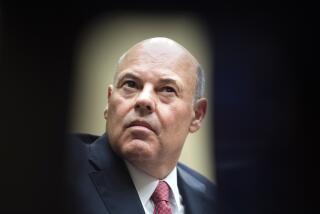U.S. economy’s strong growth isn’t expected to last

The U.S. economy grew at a 3.5% annual rate in the July-through-September quarter, the fastest pace in two years and more than the government had previously estimated. But the growth spurt isn’t expected to last.
The gain in the gross domestic product, the economy’s total output of goods and services, came from added strength in consumer spending, business investment and the government sector, the Commerce Department said Thursday. The government had previously estimated last quarter’s annual growth rate at 3.2%.
Michael Gapen of Barclays said the new report “paints a picture of a healthy consumer, likely fueled by ongoing gains in employment, modest increases in wages, and solid balance sheets.”
The economy’s acceleration last quarter marked a sharp pickup from the tepid annual growth of 0.8% in the first quarter and 1.4% in the second. Still, growth is expected to slow to a roughly 1.5% annual rate in the October-through-December quarter, reflecting in part less consumer spending and less business stockpiling.
Growth for the entire year, economists say, is likely to be around 1.5%. That would be down from 2.6% in 2015 and would be the weakest performance since the economy shrank 2.8% in 2009 at the depths of the worst economic downturn since the 1930s. The recovery began in mid-2009, but growth has averaged just over 2%, the weakest expansion in the post-World War II period.
President-elect Donald Trump, during the campaign, had criticized the sluggish pace of growth and said his economic policies would accelerate annual GDP growth to 4% or better. To do that, Trump said, he would eliminate many government regulations, boost spending on the nation’s aging infrastructure and slash taxes.
Most economists don’t think 4% growth is realistic, given a chronic slowdown in worker productivity and a slower-growing U.S. workforce due in part to retiring baby boomers.
Most forecasters expect growth of around 2.5% next year, though they say those estimates could rise if Trump wins congressional support for much of his economic program. Stock markets have risen sharply since Trump’s election, partly a reflection of optimism that his proposals would boost growth and corporate profits.
Thursday’s report was the government’s third and final estimate of GDP growth for the July-through-September quarter. The upward revision mainly reflected stronger consumer spending, which grew at a 3% annual rate, more than the 2.8% pace that was estimated a month ago. Consumer spending is closely watched because it accounts for about 70% of economic activity.
The government also revised up its estimate for business investment: It showed an increase at a 1.4% annual rate, up from a much smaller 0.1% rate in the previous estimate.
Government spending was also revised up to show growth at a 0.8% annual rate, an increase that reflected a smaller drag from cutbacks at the state and local level.
The Federal Reserve last week boosted a key interest rate by a quarter-point, just the second increase in the past decade. Fed officials say they think they can begin to gradually raise interest rates as they near their goals for full employment, and inflation increases by about 2% a year.
In public comments last week, Chairwoman Janet Yellen made no predictions about Trump’s economic program. But Fed officials forecast that they would raise rates three times in 2017, up from their previous forecast of two hikes.
ALSO
Uber pulls its self-driving cars off the streets of San Francisco
Stone tests the appetite for American craft beers in the land of Oktoberfest
Why it’s so hard to get your hands on the toy your kid really wants for Christmas
More to Read
Inside the business of entertainment
The Wide Shot brings you news, analysis and insights on everything from streaming wars to production — and what it all means for the future.
You may occasionally receive promotional content from the Los Angeles Times.










